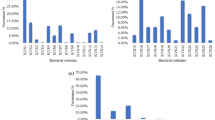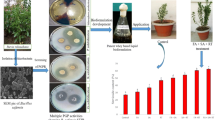Abstract
India’s livestock industry is grappling with a shortage of green fodder, necessitating concerted efforts to boost organized production and ensure a sufficient supply of high-quality forages, crucial for formulating nutritionally balanced, cost-effective, and rumen-healthy animal diets. Hence, this study was conducted to assess the plant growth-promoting characteristics of liquid microbial inoculants and their impact on the yield of forage pearl millet. The bacterial cultures utilized included Sphingobacterium sp., Stenotrophomonas maltophilia, and an isolate from vegetable cowpea, subsequently identified as Burkholderia seminalis. These cultures were initially characterized for their plant growth-promoting traits at different temperature and physiological conditions. All the bacterial cultures were found promising for PGPR traits over varied temperature conditions and the optimum activity was recorded at 40 °C, with tolerance to saline and drought stresses as well as wide pH and temperature ranges. A field experiment was conducted during kharif 2020 at Punjab Agricultural University, Ludhiana and Punjab Agricultural University, Regional Research Station, Bathinda, involving combinations of liquid microbial inoculants along with 100% Recommended Dose of Fertilizer (RDF). It was observed that the treatment including B. seminalis + S. maltophilia along with RDF yielded the highest green fodder and dry matter yield, In conclusion, it is evident that the utilization of these liquid microbial inoculants holds significant potential for playing a pivotal role in the integrated nutrient management of forage pearl millet, thereby contributing to heightened productivity and sustained soil health.


Similar content being viewed by others
Availability of Data and Material (Data Transparency)
The datasets used and/or analyzed during the current study are available from the corresponding author on reasonable request.
Code Availability (Software Application or Custom Code)
Not applicable.
References
Backiyavathy MR, Gopalan A, Vijayakumar G (2006) Nutrient management for forage crops: a review. Agric Rev 27:137–141
Bhardwaj V, Omanwar PK (1994) Long term effect of continuous rotational cropping and fertilization on crop yields and soil properties-II. Effects on EC, pH, organic matter and available nutrient of soil. J Indian Soc Soil Sci 42:387–392
Jakhar GR, Sadhu AC, Suryawanshi PK (2013) Influence of levels and methods of nitrogen application on growth and yield of summer pearl millet (Pennisetum glaucum L.). Int J Agric Sci 9(2):821–822
Yao Z, Xing J, Gu H, Wang H, Wu J, Xu J, Brookes PC (2016) Development of microbial community structure in vegetable-growing soils from open-field to plastic-greenhouse cultivation based on the PLFA analysis. J Soil Sediment 16(8):2041–2049. https://doi.org/10.1007/s11368-016-1397-2
Mwajita MR, Murage H, Tani A, Esther M, Kahangi EM, Makonde HM (2014) Molecular characterization of bacteria and fungi from rice growing regions in Kenya. Int J Biosci 5:7–14. https://doi.org/10.12692/ijb/5.3.7-14
Rai MK (ed) (2005) Handbook of microbial biofertilizers. CRC Press, Boca Raton
Baset Mia MA, Shamsuddin ZH, Wahab Z, Marziah M (2010) Effect of plant growth promoting rhizobacterial (PGPR) inoculation on growth and nitrogen incorporation of tissue cultured Musa plantlets under nitrogen-free hydroponics condition. Aust J Crop Sci 4(2):85–90. https://doi.org/10.1051/fruits:2005024
Son HJ, Park GT, Cha MS, Heo MS (2006) Solubilization of insoluble inorganic phosphates by a novel salt- and pH-tolerant Pantoea agglomerans R-42 isolated from soybean rhizosphere. Bioresour Technol 97(2):204–210. https://doi.org/10.1007/s11274-011-0708-4
Sivakumar T, Ravikumar M, Prakash M, Thamizhmani R (2013) Comparative effect on bacterial biofertilizers on growth and yield of green gram (Phaseolus radiata L.) and cow pea (Vigna siensis Edhl.). Int J Curr Res Acad Rev 1(2):20–28. https://doi.org/10.20546/ijcrbp.2016.307.015
Abdullahi R, Sheriff HH (2013) Effect of arbuscular mycorrhizal fungi and chemical fertilizer on growth and shoot nutrients content of onion under field condition in Northern Sudan Savanna of Nigeria. J Agric Vet Sci 3(5):85–90. https://doi.org/10.9790/2380-0358590
Tille P (2015) Bailey & Scott’s diagnostic microbiology. Elsevier Health Sci.
Gordon AS, Weber RP (1951) Calorimetric estimation of Indole acetic acid. Plant Physiol 25:192–195. https://doi.org/10.1104/pp.26.1.192
Schwyn B, Neilands JB (1987) Universal chemical assay for the detection and determination of siderophores. Anal Biochem 160:47–56. https://doi.org/10.1016/0003-2697(87)90612-9
Arnow LE (1937) Colorimetric estimation of the components of 3,4-dihydroxy phenylalanine tyrosine mixtures. J Biol Chem 118:513–535. https://doi.org/10.1016/s0021-9258(18)74509-2
Csaky T (1948) On the estimation of bound hydroxylamine in biological materials. Acta Chem Scand 2:450–454. https://doi.org/10.3891/acta.chem.scand.02-0450
Jackson ML (1973) Estimation of phosphorous content in soil chemical analysis. Prentice Hall, New Delhi, p 134. https://doi.org/10.1002/jpln.19590850311
Govindasamy B, Calderia K, Duffy PB (2008) Geoengineering earth‟s radiation balance to mitigate climate change from a quadrupling of CO2. Glob Planet Change 37:157–168. https://doi.org/10.1016/s0921-8181(02)00195-9
Borrow A, Brown S, Jeferrys EG, Kessel RJH, Lloyd EC, Lloyd PB, Rothwell A, Rothwell B, Swait JC (1965) The effect of varied temperature on the kinetics of metabolism of kinetics of Gibberella fujikuroi in stirred culture. Can J Microbiol 10:445–466. https://doi.org/10.1139/m64-055
Dye DW (1962) The inadequacy of the usual determinative tests for identification of Xanthomonas spp. NZJ Sci 5(4):393–416
Jadhav GG, Salunkhe DS, Devidas Punaji Nerkar DP, Bhadekar RK (2010) Isolation and characterization of salt-tolerant nitrogen-fixing microorganisms from food. Eur Asia J Biol Sci 4:33–34. https://doi.org/10.5053/ejobios.2010.4.0.5
Nguyen BAT, Hsieh JL, Lo SC, Wang SY, Hung CH, Huang E, Hung SH, Chin WC, Huang CC (2021) Biodegradation of dioxins by Burkholderia cenocepacia strain 869T2: role of 2-haloacid dehalogenase. J Hazard Mater 401:123347. https://doi.org/10.3390/microorganisms9081703
Hwang HH, Chien PR, Huang FC, Hung SH, Kuo CH, Deng WL, Chiang EPI, Huang CC (2021) A plant endophytic bacterium, Burkholderia seminalis strain 869T2, promotes plant growth in Arabidopsis, Pak Choi, Chinese Amaranth, lettuces, and other vegetables. Microorganisms 9:1703. https://doi.org/10.3390/microorganisms9081703
Ho YN, Chiang HM, Chao CP, Su CC, Hsu HF, Guo C, Hsieh JL, Huang CC (2015) In planta biocontrol of soilborne Fusarium wilt of banana through a plant endophytic bacterium, Burkholderia cenocepacia 869T2. Plant Soil 387:295–306. https://doi.org/10.1007/s11104-014-2297-0
Ho YN, Huang CC (2015) Draft genome sequence of Burkholderia cenocepacia strain 869T2, a plant-beneficial endophytic bacterium. Genome Announc 3(6):01327–01415. https://doi.org/10.1128/genomeA.01327-15
Hung SHW, Huang TC, Lai YC, Wu IC, Liu CH, Huarng YF, Hwang HH, Chiang EPI, Kuo CH, Huang CC (2023) Endophytic biostimulants for smart agriculture: Burkholderia seminalis 869T2 benefits heading leafy vegetables in-field management in Taiwan. Agronomy 13:967. https://doi.org/10.3390/agronomy13040967
Kimura M (1980) A simple method for estimating evolutionary rate of base substitutions through comparative studies of nucleotide sequences. J Mol Evol 16(2):111–120. https://doi.org/10.1007/BF01731581
Felsenstein J (1985) Confidence limits on phylogenies: an approach using the bootstrap. Evolution 39(4):783–791. https://doi.org/10.2307/2408678
Kumar S, Stecher G, Tamura K (2015) MEGA7: molecular evolutionary genetics analysis version 7.0 for bigger datasets. Mol Biol Evol 33(7):1870–1874. https://doi.org/10.1093/molbev/msw054
Ali A, Khalid R, Ali S, Akram Z, Hayat R (2015) Characterization of plant growth promoting rhizobacteria isolated from chickpea (Cicer arietinum). Microbiol Res J Int 6(1):32–40. https://doi.org/10.9734/bmrj/2015/14496
Naz I, Bano A (2012) Assessment of phytohormones producing capacity of Stenotrophomonas maltophilia SSA and its interaction with Zea mays L. Pak J Bot 44(1):465–469
Singh RP, Jha PN (2017) The PGPR Stenotrophomonas maltophilia SBP-9 augments resistance against biotic and abiotic stress in wheat plants. Front Microbiol 8:1945. https://doi.org/10.3389/fmicb.2017.01945
Kaur K (2017) Synergistic effect of Azotobacter, actinomycetes and phosphate solubilising bacteria on growth and yield of wheat (Triticum aestivum L.). Ph.D. dissertation. Punjab Agricultural University, Ludhiana, India.
Etminani F, Harighi B (2018) Isolation and identification of endophytic bacteria with plant growth promoting activity and biocontrol potential from wild pistachio trees. Plant Pathol J 34(3):208. https://doi.org/10.5423/ppj.oa.07.2017.0158
Jasim B, Jimtha CJ, Jyothis M, Radhakrishnan EK (2013) Plant growth promoting potential of endophytic bacteria isolated from Piper nigrum. Plant Growth Regul 71:1–11. https://doi.org/10.1007/s10725-013-9802-y
Viscardi S, Ventorino V, Duran P, Maggio A, De Pascale S, Mora ML, Pepe O (2016) Assessment of plant growth promoting activities and abiotic stress tolerance of Azotobacter chroococcum strains for a potential use in sustainable agriculture. J Soil Sci Plant Nutr 16(3):848–863. https://doi.org/10.4067/s0718-95162016005000060
Goswami M, Deka S (2020) Plant growth promoting rhizobacteria alleviators of abiotic stresses in soil: a review. Pedosphere 30:40–61. https://doi.org/10.1016/s1002-0160(19)60839-8
Islam F, Yasmeen T, Arif MS, Ali S, Ali B, Hameed S, Zhou W (2016) Plant growth promoting bacteria confer salt tolerance in Vigna radiata by up-regulating antioxidant defense and biological soil fertility. Plant Growth Regul 80(1):23–36. https://doi.org/10.1007/s10725-015-0142-y
Egamberdieva D, Kucharova Z, Davranov K, Berg G, Makarova N, Azarova T, Chebotar V, Tikhonovich I, Kamilova F, Validov SZ, Lugtenberg B (2011) Bacteria able to control foot and root rot and to promote growth of cucumber in salinated soils. Biol Fertil Soils 47:197–205. https://doi.org/10.1007/s00374-010-0523-3
Bashan Y, Holguin G, de-Bashan LE (2004) Azospirillum-plant relationships: physiological, molecular, agricultural, and environmental advances. Can J Microbiol 50:521–577. https://doi.org/10.1139/w04-035
Shirinbayan S, Khosravi H, Malakouti MJ (2019) Alleviation of drought stress in maize (Zea mays) by inoculation with Azotobacter strains isolated from semi-arid regions. Appl Soil Ecol 133:138–145. https://doi.org/10.1016/j.apsoil.2018.09.015
Egamberdiyeva D (2007) The effect of plant growth promoting bacteria on growth and nutrient uptake of maize in two different soils. Appl Soil Ecol 36(2–3):184–189. https://doi.org/10.1016/j.apsoil.2007.02.005
Nag NK, Dash B, Gupta SB, Khokher D, Soni R (2018) Evaluation of stress tolerance of Azotobacter isolates. Biologija. https://doi.org/10.6001/biologija.v64i1.3662
Vyas KG, Ram C, Patel NI, Singh RN (2015) Effect of biofertilisers and nitrogen management on yield and soil fertility of pearl millet under rainfed condition. Indian J Agron 10(1):319–322
Saifullah A, Munsif F, Arif M, Khan H, Ali K, Waqas M, Ali A (2011) Performance of millet varieties under different irrigation levels. Sarhad J Agric 27:1–6
Kalam S, Basu A, Podile AR (2020) Functional and molecular characterization of plant growth promoting Bacillus isolates from tomato rhizosphere. Heliyon. https://doi.org/10.1016/j.heliyon.2020.e04734
Sherpa MT, Das S, Najar IN, Thakur N (2021) Draft genome sequence of Stenotrophomonas maltophilia strain P13 gives insight into its protease production and assessment of sulfur and nitrogen metabolism. Curr ResMicrob Sci 2:100012. https://doi.org/10.1016/j.crmicr.2020.100012
Acknowledgements
The authors express their sincere thanks to Punjab Agricultural University, Ludhiana, 141004, Punjab, India.
Funding
This research work was supported by Punjab Agricultural University, Ludhiana, India.
Author information
Authors and Affiliations
Contributions
Vidhi Arora contributed to Investigation, Data curation, Formal analysis, and Writing of the original draft. Gulab Pandove contributed to Conceptualization, Supervision, Formal analysis, and Project administration. Sukhdeep Kaur contributed to Supervision and Resources. Harpreet Oberoi contributed to Supervision and Resources. Anu Kalia contributed to Conceptualization and Supervision.
Corresponding author
Ethics declarations
Conflict of interest
The authors declare there are no competing interests.
Ethics approval (include appropriate approvals or waivers)
Not applicable.
Consent to participate (include appropriate statements)
Not applicable.
Consent for publication (include appropriate statements)
Not applicable.
Additional information
Publisher's Note
Springer Nature remains neutral with regard to jurisdictional claims in published maps and institutional affiliations.
Rights and permissions
Springer Nature or its licensor (e.g. a society or other partner) holds exclusive rights to this article under a publishing agreement with the author(s) or other rightsholder(s); author self-archiving of the accepted manuscript version of this article is solely governed by the terms of such publishing agreement and applicable law.
About this article
Cite this article
Arora, V., Pandove, G., Brar, S.K. et al. Evaluating Plant Growth-Promoting Rhizobacteria to Improve the Productivity of Forage Pearl Millet. Curr Microbiol 81, 172 (2024). https://doi.org/10.1007/s00284-024-03701-0
Received:
Accepted:
Published:
DOI: https://doi.org/10.1007/s00284-024-03701-0




